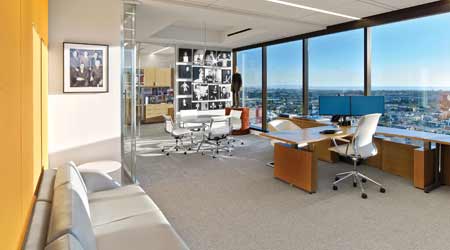 In companies like Pritzker Group shown here where top executives have their own offices, the aesthetic is often less opulent, reflecting quality and timelessness while invoking a sense of authority and leadership. Photo by Eric Laignel/courtesy of HOK
In companies like Pritzker Group shown here where top executives have their own offices, the aesthetic is often less opulent, reflecting quality and timelessness while invoking a sense of authority and leadership. Photo by Eric Laignel/courtesy of HOKWhy C-Suite Office Space Is Being Pared Down
Less opulence, more practical - that is the MO these days for executive suites.
A variety of factors is driving the move to less opulent CEO space. One big reason for the change can be traced to the Millennials’ influence. “In 2025, 75 percent of the workforce will be Millennial, and that is something you can’t ignore,” Gannon says. “They are a progressive group who wants access to leadership.” In their view, the leadership should relate to the workforce and set the pace for corporate culture. Thus, the majority of executives want “more progressive environments that involve some form of open plan.”
Scaling down the C-suite gives Millennials the open access and collaboration they crave, says Heather E. Robbins, associate and senior interior designer for Leo A. Daly. “Clients have moved to reduce the hierarchy by making the layout more equitable,” she says.
The explosion in tech companies is an important factor in pushing the gradual transition to more egalitarian and open executive spaces, says Bonnin.
The recession also changed the corporate landscape, and with “the austerity that came with the recession was a diminished appetite for opulent C-suites,” Bonnin says.
While it is important for many companies to present themselves as world-class organizations, they also “need to be cognizant of their stakeholders — clients, shareholders, and employees,” says Barnes, and the perception of how money is being spent. Rather than creating a sharp contrast between the spaces earmarked for the office staff and the executive team, more attention is being paid to buildout costs, says Barnes, and more money is being spent on highly functional/technology-rich spaces. Such rooms might have 60-inch flat screen panels functioning as a computer screen, microphones and a sound system, and state-of-the-art acoustics.
Even when the executive space has been transformed, companies still maintain areas for private meetings and heads-down work. Some companies may maintain secure and private conference rooms used only by the CEO, CFO, or the chief of the legal department.
Big picture: Workplace transformation
According to Liz Wozny, associate vice president, CallisonRTKL, executives who want to transform the workplace are more likely to be successful if they get buy-in from their staff and lead by example. If they are asking employees to give up space, it sends a more inclusive message if they do the same. “The price of real estate has a lot to do with it,” she says. “A lot more space and money are being put into shared amenities.” By reorganizing layouts and work stations, companies can invest more in staff lounges, coffee bars, social spaces, and wellness areas, and focus on company culture.
Redesigned workspaces integrate managers and more closely connect them with staff, Robbins says. For example, the executive level, the boardroom, and outdoor balconies (where they exist) may be available to everyone. “Staff meetings and events can be held in these spaces to encourage intermingling, and the spaces can be designed to encourage team members to access the executive level,” Robbins says.
Changes in technology have allowed the workforce to be more mobile and work at home, but as a result, companies have lost some of their culture. Some of those companies now want to pull people back into the office. In bringing people back inside, it’s important to focus on social spaces, collaborative meeting places, and technology, “to make sure people can function just as well in the office as they can at home — or even better,” says Wozny. It is a challenge to get people back, which is why companies are aiming to create a “resimercial design” — a cross between residential and commercial. The idea, Wozny says, is to make the office feel more like home. This may include social spaces, a gym, private areas, individual spaces, access to daylight, a treadmill work station, and the like. Such environments provide choice based on task to help people remain productive.
Related Topics:














